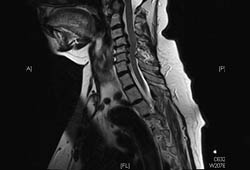颈椎病的发病率会随年龄的不同而异。以人群为基础的 MRI 研究显示,接近 100% 的年龄>40 岁的成年人,至少有一个颈椎水平(通常是 C5/6)发生严重的退行性变。[1]Matsumoto M, Fujimura Y, Suzuki N, et al. MRI of cervical intervertebral discs in asymptomatic subjects. J Bone Joint Surg Br. 1998;80:19-24.http://www.bjj.boneandjoint.org.uk/content/80-B/1/19.full.pdf+htmlhttp://www.ncbi.nlm.nih.gov/pubmed/9460946?tool=bestpractice.com[2]Guzman J, Haldeman S, Carroll LJ, et al. Clinical practice implications of the Bone and Joint Decade 2000-2010 Task Force on Neck Pain and Its Associated Disorders: from concepts and findings to recommendations. J Manipulative Physiol Ther. 2009;32(2 Suppl):S227-S243.http://www.ncbi.nlm.nih.gov/pubmed/19251069?tool=bestpractice.com[3]Braga-Baiak A, Shah A, Pietrobon R, et al. Intra- and inter-observer reliability of MRI examination of intervertebral disc abnormalities in patients with cervical myelopathy. Eur J Radiol. 2008;65:91-98.http://www.ncbi.nlm.nih.gov/pubmed/17532165?tool=bestpractice.com[4]Siivola SM, Levoska S, Tervonen O, et al. MRI changes of cervical spine in asymptomatic and symptomatic young adults. Eur Spine J. 2002;11:358-363.http://www.ncbi.nlm.nih.gov/pubmed/12193998?tool=bestpractice.com[5]American College of Radiology. ACR appropriateness criteria: chronic neck pain. 2013. http://www.acr.org/ (last accessed 9 August 2016).https://acsearch.acr.org/docs/69426/Narrative/[6]Binder AI. Neck pain. BMJ Clin Evid. 2008. http://clinicalevidence.bmj.com/ (last accessed 9 August 2016).http://www.ncbi.nlm.nih.gov/pmc/articles/PMC2907992/http://www.ncbi.nlm.nih.gov/pubmed/19445809?tool=bestpractice.com 然而,仅有一小部分患者表现为轴性颈椎痛,即使颈部放射影像学检查和 MRI 可能显示严重的自发性退行性病变,患者通常也可能无症状。[4]Siivola SM, Levoska S, Tervonen O, et al. MRI changes of cervical spine in asymptomatic and symptomatic young adults. Eur Spine J. 2002;11:358-363.http://www.ncbi.nlm.nih.gov/pubmed/12193998?tool=bestpractice.com[7]Binder AI. Cervical spondylosis and neck pain. BMJ. 2007;334:527-531.http://www.ncbi.nlm.nih.gov/pubmed/17347239?tool=bestpractice.com [Figure caption and citation for the preceding image starts]: 颈椎 MRI 显示(矢状位 T2 像):严重多节段椎间盘退行性变,但无明显脊髓受压(即:无畸形,也无内在 T2 改变)Dennis A. Turner, MA, MD [Citation ends].
[Figure caption and citation for the preceding image starts]: 颈椎 MRI 显示(矢状位 T2 像):严重多节段椎间盘退行性变,但无明显脊髓受压(即:无畸形,也无内在 T2 改变)Dennis A. Turner, MA, MD [Citation ends].
尽管目前很少有基于人群的研究,(除了有颈椎病外科治疗的研究报道),但是神经根型和脊髓型颈椎病的发生率还是较低的。[8]Rao RD, Currier BL, Albert TJ, et al. Degenerative cervical spondylosis: clinical syndromes, pathogenesis and management. J Bone Joint Surg Am. 2007;89:1360-1378.http://www.ncbi.nlm.nih.gov/pubmed/17575617?tool=bestpractice.com 由于对大多数患者来说,非手术治疗是有效的,故仅有 1%-2% 的颈椎病患者需要行手术干预治疗。[9]Matz PG. Does nonoperative management play a role in the treatment of cervical spondylotic myelopathy? Spine J. 2006;6:175S-181S.http://www.ncbi.nlm.nih.gov/pubmed/17097536?tool=bestpractice.com[10]Mazanec D, Reddy A. Medical management of cervical spondylosis. Neurosurgery. 2007;60:S43-S50.http://www.ncbi.nlm.nih.gov/pubmed/17204885?tool=bestpractice.com[11]Patil PG, Turner DA, Pietrobon R. National trends in surgical procedures for degenerative cervical spine disease: 1990-2000. Neurosurgery. 2005;57:753-758.http://www.ncbi.nlm.nih.gov/pubmed/16239888?tool=bestpractice.com[12]Rao RD, Gourab K, David KS. Operative treatment of cervical spondylotic myelopathy. J Bone Surg Am. 2006;88:1619-1640.http://www.ncbi.nlm.nih.gov/pubmed/16818991?tool=bestpractice.com[13]Salt E, Wright C, Kelly S, Dean A. A systematic literature review on the effectiveness of non-invasive therapy for cervicobrachial pain. Man Ther. 2011;16:53-65.http://www.ncbi.nlm.nih.gov/pubmed/21075037?tool=bestpractice.com
在美国,针对轴性颈椎痛症状,颈部 MRI 有相对较高的检查率,可能增加疾病接受积极干预性治疗的比例和患者对此问题的关注度。例如,由于椎间盘细胞(维持椎间盘水分)的内源性消失,椎间盘变性(例如正常含有水分的椎间盘发生脱水之后出现关节间隙狭窄)在 30 岁之后非常普遍。关节突关节则出现于更为常见的滑膜关节退行性变之后。
 [Figure caption and citation for the preceding image starts]: 颈椎 MRI 显示(矢状位 T2 像):严重多节段椎间盘退行性变,但无明显脊髓受压(即:无畸形,也无内在 T2 改变)Dennis A. Turner, MA, MD [Citation ends].
[Figure caption and citation for the preceding image starts]: 颈椎 MRI 显示(矢状位 T2 像):严重多节段椎间盘退行性变,但无明显脊髓受压(即:无畸形,也无内在 T2 改变)Dennis A. Turner, MA, MD [Citation ends].